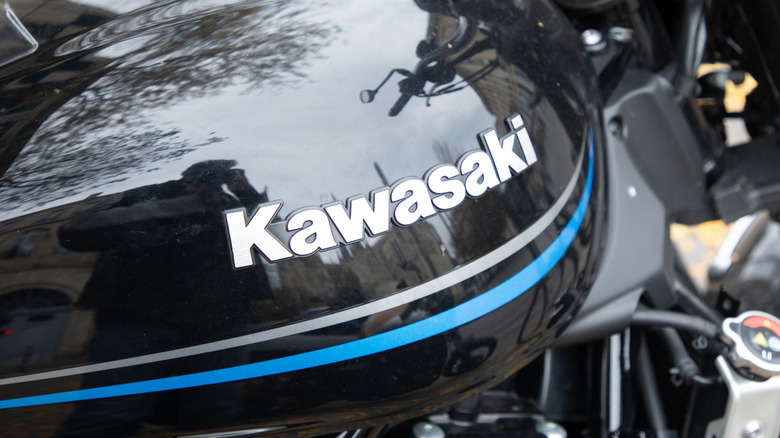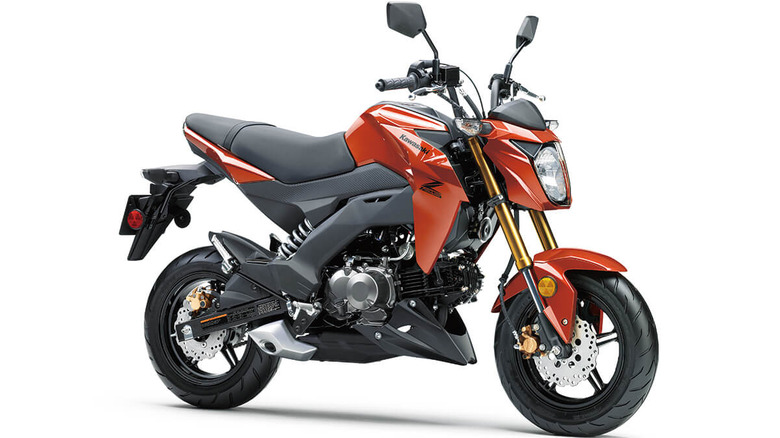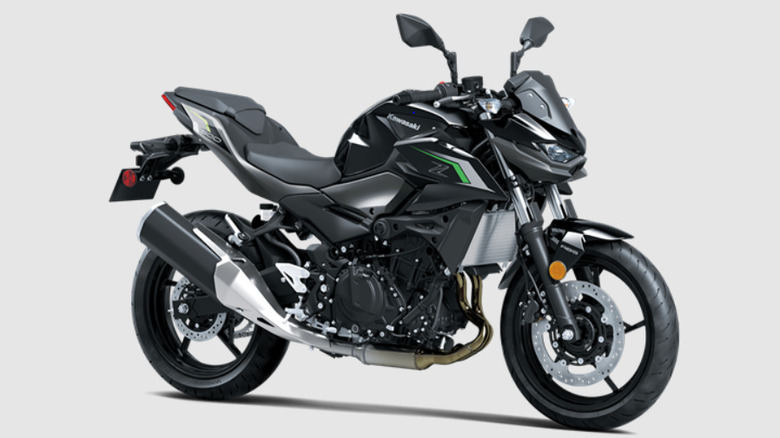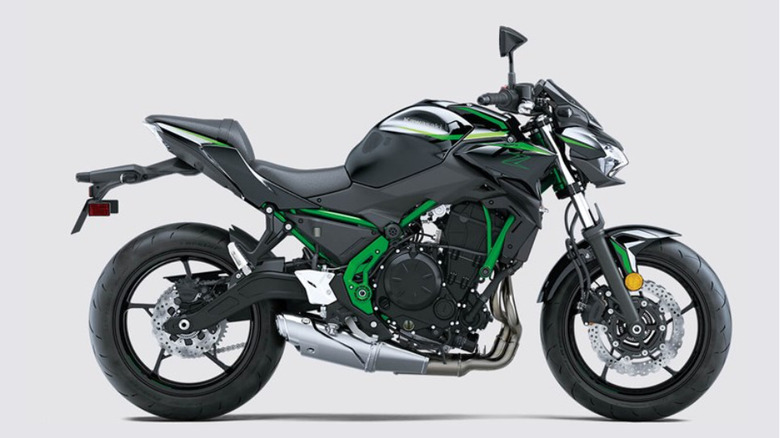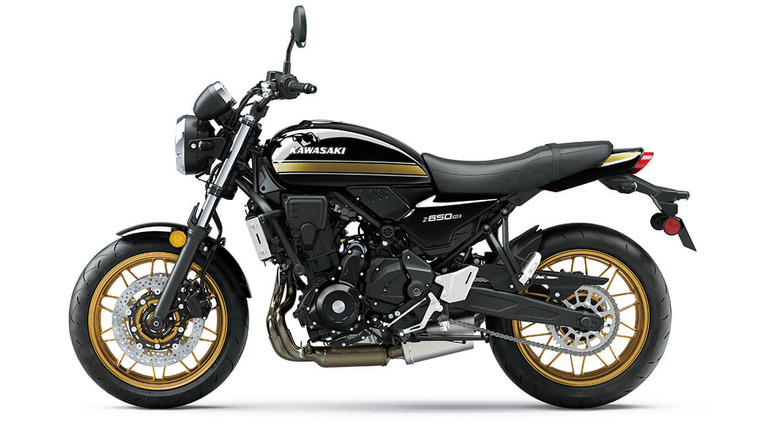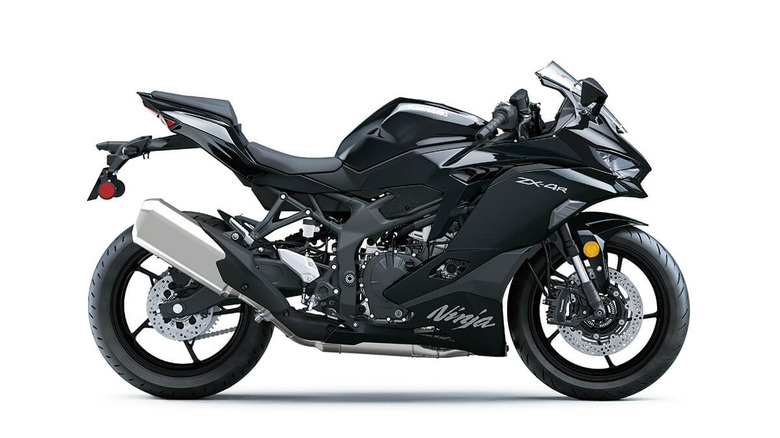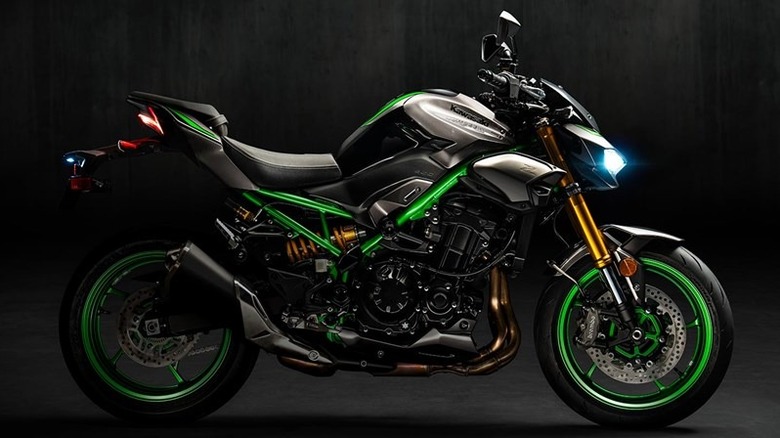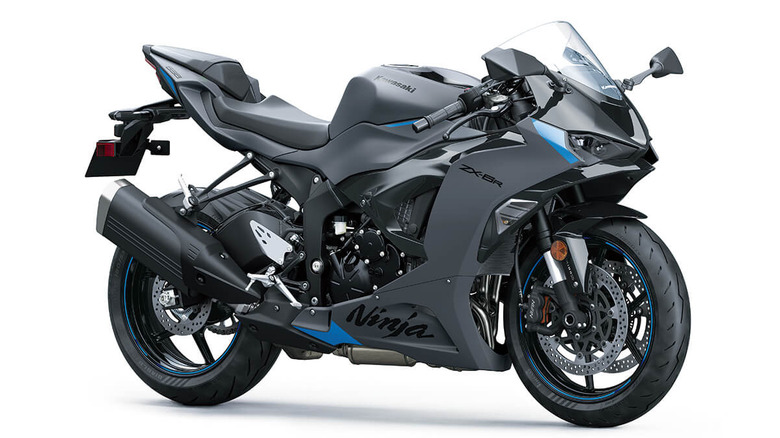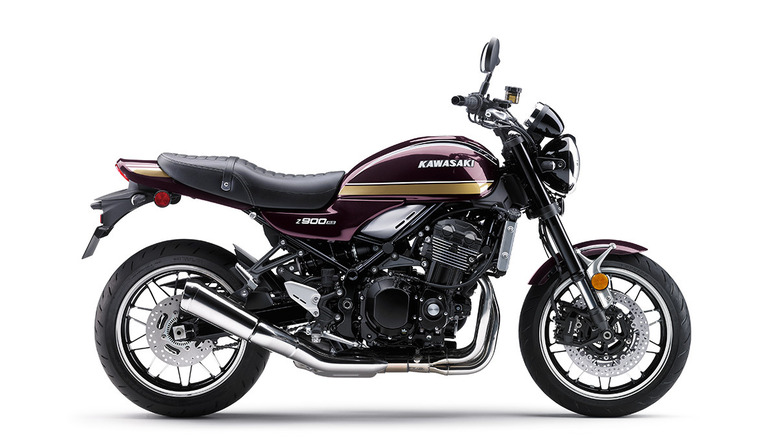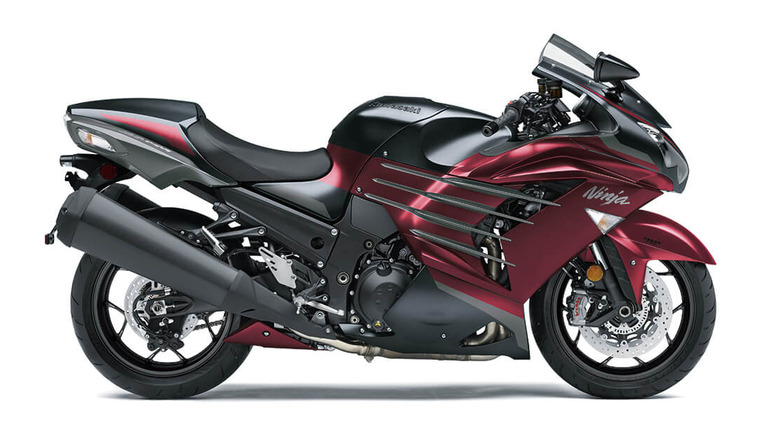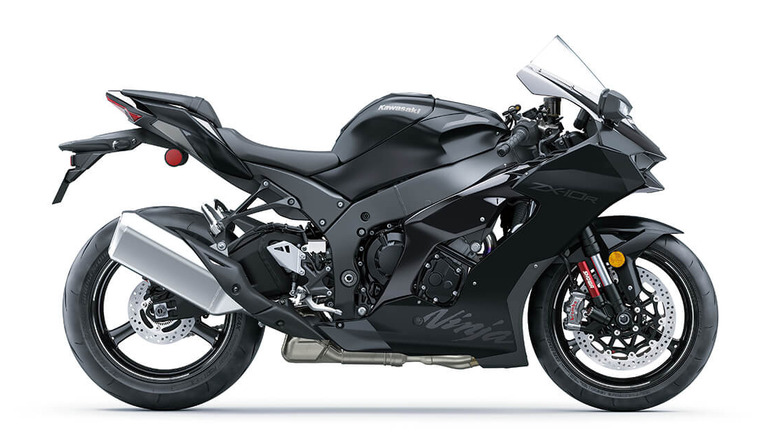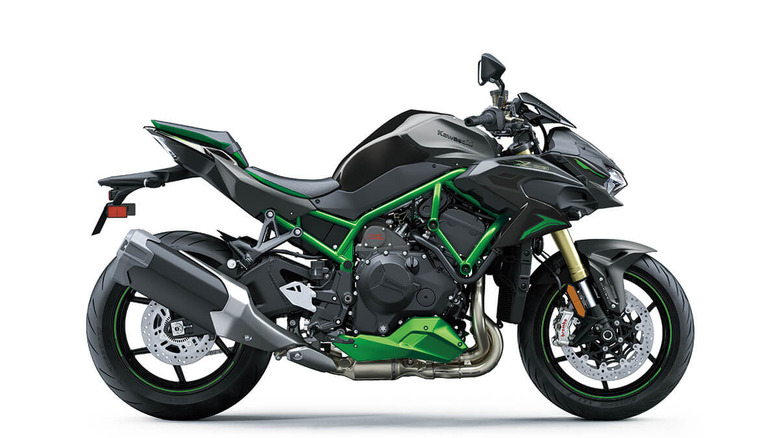Every Kawasaki Z Series Motorcycle Available In 2025, Ranked Cheapest To Most Expensive
The Kawasaki brand dates back to 1878, when founder Shozo Kawasaki established the Kawasaki Tsukiji Shipyard in Tokyo. However, its motorcycle involvement wouldn't begin until it produced it's first model in 1961. And since then, Kawasaki has improved its bikes consistently to survive and thrive in a fiercely competitive market. Whether in one of the most famous motorcycles ever made or on the MotoGP race track, the brand's built a legendary name for itself.
Each of the Big Four builders associates its motorcycles with a few letters. Suzuki has the GSX, Honda has the CBR, and Yamaha has its YZF. For Kawasaki, it has been the letter Z, often followed by an X. Whether a part of the vaunted ZX Ninja series or the legendary GPZ900R that kickstarted the supersport era, when it came to Kawasaki, Z meant performance. There is perhaps no better evidence for the company's state than in the latest Z-series bikes to emerge from its factories.
Kawasaki has granted the Z designation to 11 of its 2025 model year motorcycles. Despite the association with serious performance, the line is broad enough to include bikes for everyone from beginners to experts at several price points. We run down the prices, specs, and target riders for each of Kawasaki's 2025 Z series motorcycles, ranked by price.
Z125 Pro — $3,699
The Z125 Pro kicks off Kawasaki's 2025 offerings, being cheaper and smaller than any other Z-series headed our way this year. Most companies take care to develop solid small-displacement motorcycles. After all, getting new riders into your ecosystem at the beginning could guarantee decades of brand loyalty. Still, 125cc is smaller than many would expect.
At first glance, the styling of the Z125 doesn't let on to its diminutive stature. It has rakish angles and a mean half-fairing streetfighter look, and it's only next to something that its scale becomes apparent.
A 2-gallon fuel tank feeds a single-cylinder engine via a fuel injection system. The Z125 Pro is no minibike with electric start, a four-speed manual Kawasaki transmission, and a sophisticated digital dash. It even offers a quartet of suspension preloads to tailor to your riding style, including adding a passenger.
You should hope your passenger isn't that heavy, though. The Z125 is a neat little bike, and it could be the perfect introduction to street riding for the right rider. Unfortunately, that rider would need to be small and light to get the most out of it. But starting at between $3,699 and $3,899 plus a destination fee of $305, the price is certainly right.
Z500 — $5,599
A significant step up in displacement leads us to the next bike on the list, the Z500. As the name suggests, this bike approaches the 500cc class, with an official displacement of 451cc. Splitting the displacement is a pair of parallel cylinders in a liquid-cooled engine mated to a six-speed transmission. Kawasaki claims a power rating of 51 hp at 10,000 RPM and 31.7 lb-ft of torque at 7,500 RPM. Considering the overall curb weight of 366 pounds, that's a respectable amount of horsepower.
Kawasaki intends this to be a light middleweight bike that could provide an excellent platform for gaining experience. The seat height is 30.9 inches, far lower than some supersport and adventure bikes, and suitable for shorter riders.
Yet the Z500 is not short on amenities. There are two models available. The Z500 ABS starts at $5,599 while the upscaled Z500 SE ABS asks $6,299. Both models share LCD instruments, smartphone connectivity, a slipper clutch, anti-lock braking systems, and a $600 destination charge.
The Z500 SE ABS includes an upgraded TFT display, pillion seat cover, tank and knee pads, USB-C outlet, and special edition graphics for those who want something a tad out of the ordinary. The Z500 would probably not be a thrill for those used to liter bikes, but most of the fun happens between 40 and 80 mph, and this little street machine could be just the ticket for the right rider.
Z650 — $7,249
While riders once had few sport bike options outside of blisteringly fast supersports, times have changed. The Z650 is another entry into Kawasaki's aggressively styled naked streetfighter aesthetic.
Employing a similar engine architecture to the Z500 SE ABS, the Z650 also employs a liquid-cooled parallel twin setup, though with a little more boom room for its pair of cylinders. Part of the beauty of a good middleweight is its ability to cater to a vast spectrum of riders. At 649cc, the Z650 is square in the center of the middleweight category, tipping the scales with a curb weight of 414.5 pounds.
Set against a claimed 67 hp at 8,000 RPM and 48.5 lb-ft of torque at 6,700 RPM, the Z650 is light enough to suit beginner riders while providing intermediate and even advanced riders with enough pep to be genuinely thrilling.
The Z650 includes most of the gizmos and gadgets one would expect from a brand-new Big Four bike. Smartphone connectivity, a 4.3-inch TFT color display, optional anti-lock brakes, and Kawasaki's Traction Control (KTC) system with multiple modes fill out a respectable basket of goodies.
Depending on the rider's maturity, physical dimensions, and ability, the Z650 base starts at $7,249 without ABS and $7,749 with it included. Both options add the obligatory $665 destination charge.
Z650RS — $8,899
The Z650RS is another take on the 650 platform, with a few differences from the Z650, not the least of which is a bigger price tag. Kawasaki refers to the styling behind the RS as a "retrovolution," and one glance at the bike shows why. Gone are the naked angles that have populated this list so far in favor of a smoother and more forgiving visual design that hearkens back to some of the most eye-catching Kawasaki motorcycles in history.
Under the skin, the Z650RS shares much with the Z650, including the 67 hp at 8,000 RPM and the 6,700 lb-ft of torque at 6,700 RPM. That power is sourced from the same 649cc parallel twin as the Z650. However, Kawasaki tuned the bike for low to mid-range performance, giving the RS a friendly around-town riding experience hinted at by its upright seating position and casual styling.
The primary difference between the Z650 and Z650RS is their looks. Some people just don't like the menace of a hyper naked or supersport bike. The RS comes in to save the day with more mellow styling and a black-and-gold color scheme that will take riders of a certain age right back to the glory days. Whether or not that feeling is worth the $8,899 price tag (plus a $665 destination charge) is up to the buyer.
Ninja ZX-4R — $8,999
We go down in displacement, but up in price to land on the Ninja ZX-4R. It's cordoned off on the Kawasaki website from the other bikes on this list, but this is very much a Z-series (though its lineage does overlap with the Kawasaki Ninja line).
While supersport aficionados were once relegated to 600cc and 1,000cc models, motorcycle builders have sought to make the once-intimidating class a little more inviting. While some manufacturers cut displacement by reducing the number of cylinders, the ZX-4R is an exception. A 399cc inline four-cylinder powers this Ninja, making it the first bike on this list to employ the traditional supersport configuration.
As ready for the street as the track, the ZX-4R has the bells and whistles, including KTRC, a slipper clutch, different power modes, and smartphone connectivity. With a curb weight of 414.5 pounds and a claimed 56 hp at 11,500 RPM and 26.5 lb-ft of torque at 11,500 RPM, it promises the feel and sound of a supersport with (as much of) the risk of watching your bike cartwheel down the street without you after you tweak the throttle by accident.
Though heavier and more experienced riders may want to opt for the ZX-4R's bigger siblings, it provides an excellent and exciting entry into the world of knee-dragging (on approved tracks with the right equipment only, of course). The bottom line is that super performance is much more accessible, and it comes in at $8,999 plus a $600 destination charge.
Z900 — $9,999
The Z900 officially brings us out of bikes that could be considered for beginners. The Z900 is nothing short of a full-sized streetfighter. Its looks scream aggression, and its performance backs it up.
A 948cc in-line four-cylinder lies at the heart of the Z900. With a claimed 123 hp at 9,500 RPM and 73 lb-ft of torque at 7,700 RPM, it's got more than enough power to keep even the most advanced riders entertained. While it might not be as featherlight as some supersport-oriented bikes, its 470-pound curb weight is hardly onerous. Heck, it even made our list of the most powerful Z-series naked bikes in Kawasaki's stable.
Kawasaki fills out the model with a slew of performance- and convenience-oriented amenities. A 5-inch TFT color screen displays critical information, including an economical riding indicator, and Kawasaki's Rideology app is present for wireless smartphone connectivity. From a performance perspective, an inertial measuring unit (IMU) works with the KTRC seen on bikes lower on the price spectrum, in addition to the Kawasaki Cornering Management Function (KCMF), and even a race-style quick-shifter.
The Kawasaki naked look may be an acquired taste, but if you've acquired it, the Z900 has it in spades. A tubular trellis frame embedded within Kawasaki's Sugomi design cues gives it an almost alien but undeniably menacing presence, sitting on its kickstand or screaming down an expressway. All for $9,999 plus an $815 destination fee.
Ninja ZX-6R — $11,399
The Ninja ZX-6R, a super street bike classic, holds a significant place in the history of motorcycles. Its reign during the '90s and early aughts is a testament to its enduring legacy, with the only major change being the shift from the 599cc engines of the old 600 class to the 636cc engine of the Ninja middleweight.
The extra displacement seems to do the trick, because it brings 127 hp and 52 lb-ft of torque to the party against a curb weight of 436 pounds. It also includes the fun toys like a 4.3-inch TFT display and Rideology connectivity, along with 310-millimeter front brakes linked up to Kawasaki's Intelligent Anti-Lock Brake System (KIBS) — though that last bit only comes on the ABS model.
The Ninja ZX-6R comes in three trims, each offering a unique combination of features and price points. The entry-level, non-ABS edition is priced at $11,399, while the ABS model is available at $12,399. Additionally, Kawa offers its KRT edition at the same price points, outfitted in Kawasaki's trademark neon-green racing livery. For those of us who fell in love with the Ninja back in the '90s, the 40th Anniversary Edition ABS with green wheels and a retro paint scheme is also available.
Z900RS — $12,649
The Z900RS is to the Z900 what the Z650 RS is to the Z650. That's a lot of numbers and Zs, so we'll break it down nice and easy for you. Kawasaki's strategy seems to be providing something for everyone. As mean and menacing as the Z900 is, the RS is the softer, retro, and, we must admit, handsome sibling.
The bikes are technologically similar, sharing the 948cc in-line four-cylinder powerplant. The RS incorporates a classic round headlight, teardrop fuel tank, and a two-up seat that provides the passenger with more than a postage stamp of butt space.
Kawasaki offers the Z900RS in a few flavors, including the entry-level ABS model, a cafe-racer-inspired model with a front cowl in the Z900RS Cafe, and the performance-oriented Z900 RS SE ABS, which includes an Ohlins rear shock and Brembo front brakes. The fun starts at $12,649 for the entry level and climbs to $14,149 for the top-of-the-line model, not including the $815 destination charge.
Ninja ZX-14R — $17,599
The mighty have fallen, but not that far. The Ninja ZX-14R was once the top of the speed line for Kawasaki. Today, it has taken on a marginally more mellow role as a reborn sport-touring monster.
A digitally fuel-injected 1,441cc in-line four-cylinder engine powers this baby to the tune of a neck-snapping 197 hp and 116.5 lb-ft of torque at 10,000 and 7,500 RPM, respectively. It weighs a bit more than the super sports with a 593-pound curb weight. A set of four-piston Brembo M50 brakes brings its bulk (if that's what you want to call it) to a smooth stop or leaning through corners. Kawasaki poured some effort into its latest ZX-14R, including a monocoque frame, KTRC, and an anti-lock braking system.
The design is also a departure from the other bikes on this list. The Ninja ZX-14R ditches the angles and embraces a flowing curve that makes it look like it's slicing through the wind even at a standstill. The ZX-14R is the bike for the experienced sportbike rider who is finally ready to ditch the scrunched-up seating position of the top liter bikes (looking at you, Yamaha YZF-R1). Don't get us wrong, this thing is no Gold Wing, but it provides an opportunity to blow off the young whipper snappers on R6s without losing feeling in your hands. For the right rider, that's more than worth the $17,599 plus $815 destination cost.
Ninja ZX-10R — $17,999
For another $500, buyers can come down from the ZX-14R to the Ninja ZX-10R. That might sound like more money for a demotion, but hear us out. The ZX-10R (and the entire 1,000cc superbike class) is a holdover from the olden days, but that doesn't mean the technology is.
Kawasaki keeps its liter bike torch lit with a 998cc four-cylinder double overhead cam engine, claiming 196 hp and 84 lb-ft of torque. That power is insane against its 456-pound curb weight, but it's just the beginning.
Kawasaki has thrown everything at the ZX-10R, including launch control, corner management, a racing quick shifter, various power modes, and a sport version of its KTC system. Chassis management includes an advanced inertial measurement unit and an intelligent anti-lock braking system.
The ZX-10R is arguably the most track-oriented motorcycle in Kawasaki's current stable. With its classic displacement class mated to decades of Kawasaki sportbike development, there is little a supersport aficionado can ask for that it doesn't have.
Like the ZX-6R, the 10R comes in a few trims, including offering the paint options that come with the KRT and anniversary edition, and an upcharge for ABS that can raise the initial $17,790 asking price by $1,000 or so. Where it goes further, however, is in the $30,499 ZX-10RR trim for the hardcore track-day riders. For the extra outlay, buyers get upgraded engine internals, an Ohlins steering damper, advanced intake, and a bunch of other goodies that will make you top of the track.
Z H2 — $21,700
Many companies' offerings end with the supersport liter category, or perhaps a 1,000cc-plus sport cruiser a la the ZX-14R, but Kawasaki goes a step further. The Kawasaki H2R is nothing short of the fastest production motorcycle in the world, and Kawasaki offers a Z-model it terms a hypernaked.
The Z H2 boasts a 998cc in-line four cylinder, similar to the ZX-10R, but with a game-changing addition. Kawasaki has ingeniously integrated a supercharger into the already formidable engine. In its Z H2 form (Kawasaki manufactures several H2 variants), this results in a staggering 197 hp, equivalent to the ZX-10R, but with a torque boost from 84 to 101 lb-ft. This is an impressive feat for a bike weighing 531 pounds, considering the added weight of superchargers.
The Z H2 is not just a high-performance motorcycle, but also a smart investment. It comes with a full suite of Kawasaki rider aids and gadgets, making it the flagship bike in a line of new and old legendary offerings from a company that truly knows what it is doing. Priced at a reasonable $21,700 plus the standard $815 destination charge, it offers a lot of bang for your buck. For those who crave even more power, there's the $59,000 Ninja H2R with its 321 hp. It may not be a Z-bike, but it's a tempting option.
